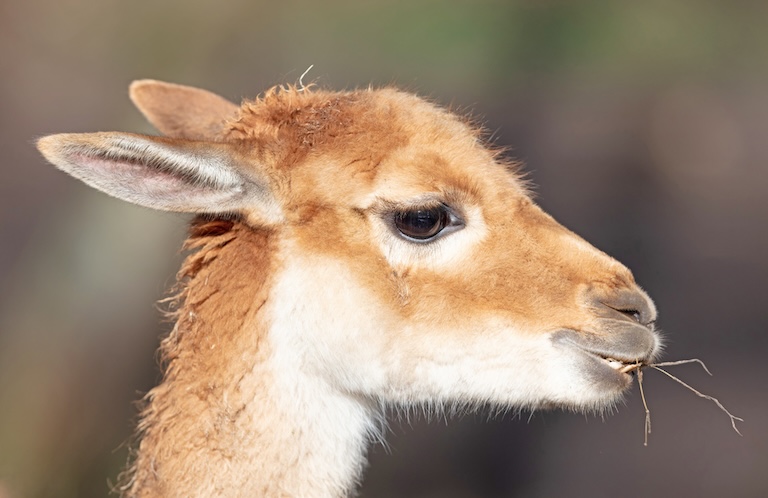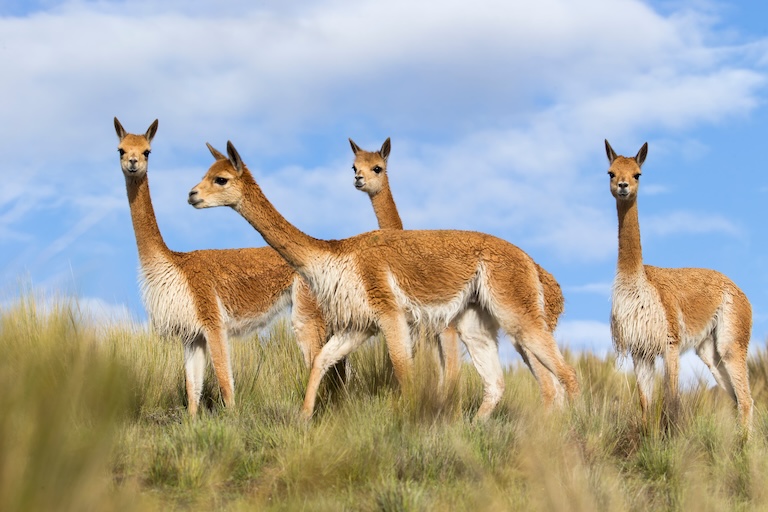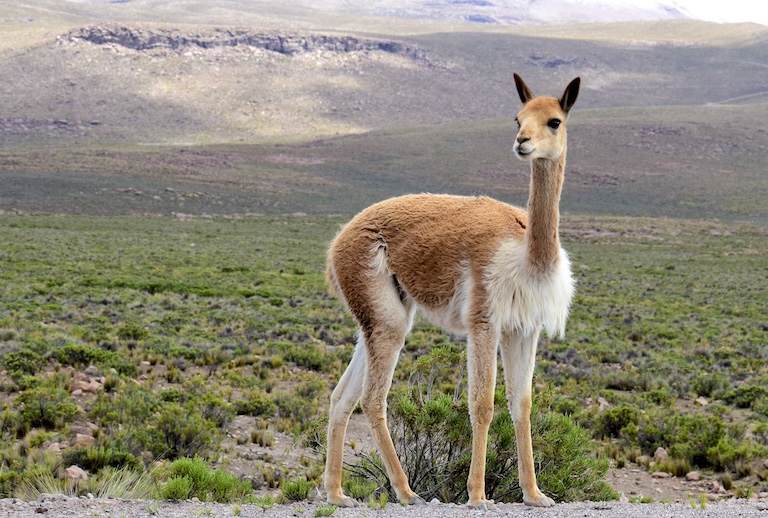Vicuña Profile
Camelids are a strange lot. Aside from looking really, really, funny, they’re quite unusual as a group. They’re not horses, they’re not bovids, and they don’t seem to come from anywhere they’re currently found in the wild.
Camelids first showed up in North America. Then some grew to 3 meters tall, developed humps, and spread to Europe and Africa.
Others took advantage of the Great American Interchange to enter South America and look weird down there. Vicuñas are one of the latter group, a branch of relatively small camelids that escaped human interference for a lot longer than their humpy cousins, but, as we’ll see, eventually succumbed to it.

Vicuña Facts Overview
| Habitat: | Mountainous, semiarid grasslands and plains at elevations ranging between 3km and 5km |
| Location: | Peru, Northwestern Argentina, Bolivia, and northern Chile |
| Lifespan: | Up to 20 years in the wild |
| Size: | 1.60m (5.2 ft) in length |
| Weight: | Up to 65 kg (145 lb) |
| Colour: | Tawny brown on the back, white on the throat and chest |
| Diet: | Grasses |
| Predators: | Pumas and the culpeo (Andean fox) |
| Top Speed: | Unknown |
| No. of Species: | 1 |
| Conservation Status: | Least Concern (IUCN) |
Vicuñas are now found solely in South America, predominantly in the mountainous regions of Bolivia, Peru, Chile, Argentina, and Ecuador.
While native to all these countries except Ecuador, a population of about 2,000 animals was introduced in Ecuador in 1988.
This was part of a desperate drive to recover populations from rampant overexploitation by the conquerors of the continent who took ancient, sustainable harvesting practices and threw them out the window.
Luckily, it worked, and vicuñas are on the rise in South America.
These small social camelids have one of the most expensive textiles in the world on their backs, so looking after them has become a priority for the wealthy.
Interesting Vicuña Facts
1. They’re camelids
Vicuñas look a lot like antelope at first glance, with their slender legs and long necks, but it’s their faces that give them away. While they’re a lot less pillow-like than llamas and alpacas, and far shorter and less humpy than Bactrians and dromedaries, vicuñas have that special sort of camel face that looks a bit like a hare bred with a deer.
That’s because they are members of the camel family, one of two genera that includes the well-known camels (Camelidae) and the South American camelids in the Lama genus.
50 million years ago, this family began as a rabbit-sized genus of camel, evolving to the size of a goat 35 million years ago, and then diverging in North America into the various ancestors of today’s species. The ancestor species of Vicuñas migrated into South America when it finally connected with North America and diverged into the four Lama species today.
Humans migrated onto the continent around 2.5 million years later and quickly identified the value of these small camelids as domestic animals. 1

2. They’re social
Before they were bothered by the naked ape, vicuñas evolved to be very social herbivores. There are three main configurations of vicuña social groups: the family herds, in which females and their juvenile offspring travel together; the bachelor herds, in which roaming bands of young males go out on the town looking for action; and the solitary herds, which are essentially rejected males with few prospects, just hanging out for safety.
Male vicuñas are territorial, and during mating season they will defend both their territories and any females they manage to persuade. They’ll also work to distract and run off with females from other territories around this time. 2
3. But they’re terrible parents
It seems as though vicuñas put more effort into mating than actually looking after the resulting spawn. Female parental investment is relatively low, and females will run off and abandon their babies if they get a fright.
Males don’t directly appear to be interested in parenting, either, but will at least defend their territories in general.
Among ungulates, there are two classic points on the spectrum of offspring protection strategy. These are known as the “follower” and “hider” types, and most will lean towards one strategy over the other. Offspring of the hider types are generally stationary and will hide while the mother feeds and gathers nutrients before she returns to the young to nurse.
Vicuña offspring are the follower type, and this means they are highly mobile quite early on, and will stick with the herd for safety.
Despite staying close to their mothers, many young vicuñas are left alone when the herd gets spooked and runs off. The mother-offspring care is at its highest in the first month, dwindling over the course of the offspring’s development. 3
4. They shout
One way to ensure they’re not entirely forgotten is to make a lot of noise. Vicuñas tend to be all or nothing with their vocalisations, and the most common sound coming out of one is a loud alarm call.
The resident male is usually the first to sound the alarm; a high-pitched scream that lasts three or four seconds. Other members might join in, and the group moves away from the threat, with the male following up the rear for protection. 4
5. Their wool is exceptional
Vicuña wool is some of the finest on Earth. For reference, alpaca wool, known to make excellent warm clothing, is made of fibres 23 microns thick. Vicuña fibres are 13 microns, making exquisitely fine wool that can be woven into high-fashion garments.
This is one of the most expensive textiles in the world, and a good vicuña wool coat can go for $35,000 US.
The native peoples were well aware of this quality fabric, and during the Incan empire, only the emperor was allowed to wear woo from a vicuña. This elitism was so extreme that anyone else caught wearing it would be executed.
6. It was traditionally a sustainable harvest
Having only one dude wearing vicuña wool certainly made the harvest a lot less intensive. There are only so many coats you can have, even as an emperor, and for the longest time, vicuña wool harvesting was done sustainably.
Every four years, vicuñas were rounded up by villagers and sheared, before being released without harm. This put very little strain on the population and would have been a great way to ensure vicuñas continued to thrive on the continent, had it not been for some pesky colonisers.

7. Until the Spanish ruined everything
The population of vicuñas began to rapidly decline towards extinction when the Spanish conquered the Incan Empire. The Spanish hunted vicuñas with guns rather than following the traditional method of catching and releasing them.
They also brought in sheep, goats, cows and horses, which quickly began replacing camelids in the best pastures of the Andean region. This was the beginning of the end for South American biodiversity in general, a situation that has now become dire with the continued and rampant destruction of the Amazon in favour of monocultures for animal agriculture.
The vicuñas were caught up in the confiscation of herds from local people, over-exploitation for their wool and meat, and the loss of ancient breeding practices. 5
8. Things are a bit better now
Conservation efforts always come pretty late in the game, but in best cases, they’re very effective. And for the vicuñas, who were once overexploited for their valuable fibre, they have shown great success.
Fortunately for the species, vicuña wool is a prized commodity of the elites, who are very interested in protecting their bounty, so today, vicuñas have bounced back from the brink and are still on the rise.
Vicuña Fact-File Summary
Scientific Classification
| Kingdom: | Animalia |
| Phylum: | Chordata |
| Class: | Mammalia |
| Order: | Artiodactyla |
| Family: | Camelidae |
| Genus: | Vicugna |
| Species: | Vicugna |
Fact Sources & References
- K. Kris Hirst (2018), “Llamas and Alpacas”, Thought Co.
- Marcelo Cassini (2018), “Sociality, Foraging and Habitat Use by Vicuña”, Springer Link.
- Bibiana Vila (2010), “Mother‐Offspring Relationship in the Vicuña, Vicugna vicugna (Mammalia: Camelidae)”, Research Gate.
- Margaret Salter, “Vicugna vicugna vicugna”, Animal Diversity Web.
- WILLIAM R. LONG (1993), “Environment : Bouncing Back : The vicuna makes an impressive comeback in Peru while its cousin the llama gains popularity in the United States.”, Los Angeles Times.
